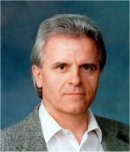|
|
Keynote
Lecture
Fundamental Laws of Nature:
Mass-Energy, Work, Heat and Entropy
From Reversible Isentropic to Irreversible Caloric
Processes

Professor M. Kostic
Department of Mechanical Engineering
Northern Illinois University
DeKalb, IL 60115-2854, USA
E-mail: kostic@niu.edu
Abstract: The phenomenological Laws of
Thermodynamics have much wider, including philosophical
significance and implication, than their simple
expressions based on the experimental observations –
they are the Fundamental Laws of Nature. The Fundamental
Thermodynamic Laws of Nature (The First, Second, Zeroth
and Fourth) are defining and unifying our comprehension
of all existence in universe (all natural systems
defined by their properties and processes) and all
changes in time (all natural processes, including life),
which are in turn caused by mass-energy transfer, from
one system or subsystem to another, due to non-uniform
mass-energy distribution in local space and/or universe.
Due to universality and diversity of Thermodynamics (The
Laws of natural, including man-made processes and
properties), it appears to be abstract and difficult to
comprehend, regardless that the “cause-and-effect” Laws
of Nature are obvious, logical and simple. The
fundamental Laws of Nature are exceptionally simple but
they appear in exceptionally many different forms, which
explain universality and unity of simplicity and
complexity, but also difficulties to recognize
simplicity in complex diversity.
The basic concepts will be systematically defined and
illustrated first by simple ideal-gas systems and
reversible processes, and then expended to real systems
and unavoidable process irreversibility. The hart of
Thermodynamics is energy, which is ‘contained’ within,
i.e. defines a mass-energy system which occupies a
space, and thus is the ‘building block’ and fundamental
property of matter and space, and in turn, the
fundamental property of existence. Furthermore, the mass
and energy are manifestation of each other and are
equivalent; they have a holistic meaning of mass-energy.
Moreover, energy exchanges from one to another system or
subsystems are related to energy transfer in time across
a real- or imaginary-interface boundary-surfaces between
and within the systems, i.e. energy transfer is
associated with all processes (or changes) and, thus,
indivisible from time. The forces, causing the
mass-energy displacement/transfer, thus defining the
process direction are manifested by tendency or actual
mass-energy transfer due to non-equilibrium of
mass-energy in space. The non-equilibrium, i.e.,
non-uniform distribution of mass-energy in space tends,
in time, to spontaneously and irreversibly redistribute
over space towards common equilibrium, thus
non-equilibrium cannot be spontaneously created. All
natural spontaneous, or over-all processes (proceeding
by itself and without interaction with the rest of the
surroundings) between systems in non-equilibrium have
tendency towards common equilibrium and thus
irreversible loss of the original work potential
(measure of non-equilibrium), by converting
(dissipating) other energy forms into the thermal energy
accompanied with increase of entropy (randomized
equi-partition of energy per absolute temperature
level). These fundamental concepts will be revisited and
highlighted using typical and characteristic natural
processes with an objective to explain, clarify, and
resolve any misunderstanding by correlating and unifying
different approaches and nomenclature, related to the
universal concept of mass-energy in space and time.
The philosophic axiom "causa aequat effectum," traced to
ancient philosophers, represents the most universal and
fundamental law of nature, including existence and
future, i.e. past and future transformations. By the
beginning of the 20th century scientists had established
conservation laws governing the following quantities:
energy, mass (or matter), linear momentum, angular
momentum, and electric charge. Conservation laws have
the broadest possible application of all laws in physics
and are thus considered by many scientists to be the
most fundamental laws in nature. As such the fundamental
laws are taken as axiomatic and many believe they could
not be questioned, explained or proven. However,
everything may and should be questioned, reasoned,
explained and possibly proven. The miracles are until
they are comprehended and understood.
Brief Biography of the Speaker:
Milivoje M. Kostic, Ph.D., P.Eng., Professor of
Mechanical Engineering at Northern Illinois University,
is a notable researcher and scholar in energy
fundamentals and applications, including nanotechnology,
with emphasis on conservation, environment and
sustainability. He graduated with the University of
Belgrade highest distinction (the highest GPA in ME
program history), obtained Ph.D. at University of
Illinois at Chicago as a Fulbright scholar, appointed as
NASA faculty fellow, and Fermi and Argonne National
Laboratories faculty researcher. Professor Kostic also
worked in industry and has authored a number of patents
and professional publications, including invited
articles in prestigious energy encyclopedias. He has a
number of professional awards and recognitions, is a
frequent plenary speaker at international conferences
and at different educational and public institutions, as
well as member of several professional societies and
scientific advisory boards.
More at www.kostic.niu.edu (See C-Vita for more
information).
|
|
